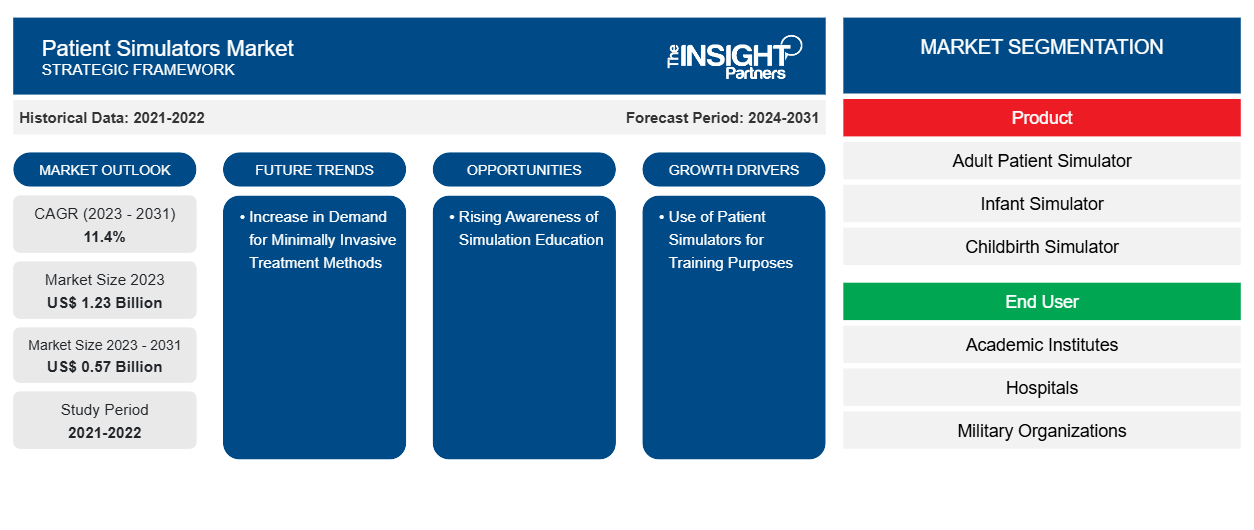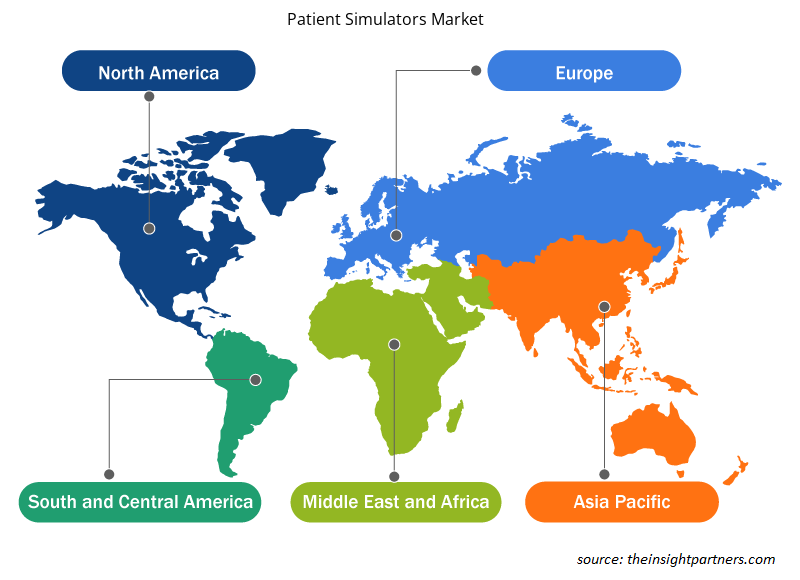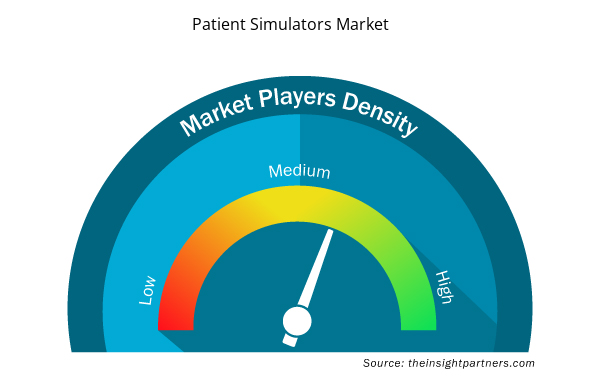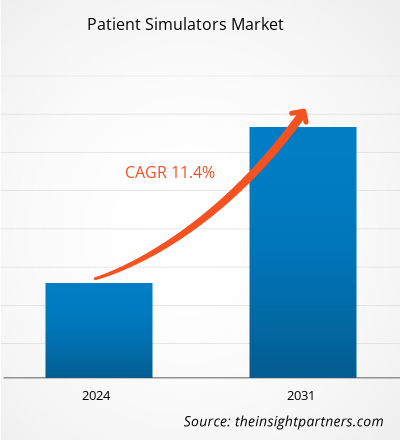The patient simulators market size is projected to reach US$ 0.57 billion by 2031 from US$ 1.23 billion in 2023. The market is expected to register a CAGR of 11.4% during 2023–2031. Growing technological advancements in patient simulators is likely to remain a key trend in the market.
Patient Simulators Market Analysis
Key factors that are driving the growth of the market are growing demand for patient simulators to train medical professionals and increase in demand for minimally invasive treatment methods. However, the high cost of patient simulators is expected to hamper the market during the forecast period. Furthermore, rising awareness of simulation education has created growth opportunities for the patient simulators market over the upcoming forecast period.
Patient Simulators Market Overview
Patient simulation allows healthcare practitioners and students to develop the technical and professional skills required in their chosen fields without the risks inherent in managing human patients. Training models not only allow students to acquire hands-on practice, but they also provide an excellent visual. The high-fidelity simulators have pulses, breath, heart rhythms, and blood pressure that can be detected and displayed on real medical equipment, just as on live patients. These features engage the learner's emotions and provide a realistic learning environment, allowing them to be immersed in the exercise and treat the simulated patient just as they would a live patient. The use of simulation-based training tools in surgery is rapidly increasing and has shown favorable alternative training modes allowing for surgical skill enhancement despite workplace pressures. The major role of simulation is to train those preparing for or working in healthcare delivery. Simulation-based training can transform a team of experts into an expert team. Thus, the growing use of simulators in teaching hospitals, nursing schools, military medical training, and paramedic training centers for training purposes is driving the patient simulators market.
Customize This Report To Suit Your Requirement
You will get customization on any report - free of charge - including parts of this report, or country-level analysis, Excel Data pack, as well as avail great offers and discounts for start-ups & universities
Patient Simulators Market: Strategic Insights

- Get Top Key Market Trends of this report.This FREE sample will include data analysis, ranging from market trends to estimates and forecasts.
Customize This Report To Suit Your Requirement
You will get customization on any report - free of charge - including parts of this report, or country-level analysis, Excel Data pack, as well as avail great offers and discounts for start-ups & universities
Patient Simulators Market: Strategic Insights

- Get Top Key Market Trends of this report.This FREE sample will include data analysis, ranging from market trends to estimates and forecasts.
Patient Simulators Market Drivers and Opportunities
Increase in Demand for Minimally Invasive Treatment
A minimally invasive medical procedure is generally performed by entering the device in the body through the skin, a body cavity, or an anatomical opening, but with the least damage possible to these structures. In recent years, significant improvement has been made in cardiovascular disease treatment. However, these complex medical procedures require rich experience and technical expertise. The complex treatment of cardiovascular diseases is made more comfortable with the help of simulators. The system can produce realistic 3D vascular models segmented from patient datasets, which include a beating heart, and give a real-time computation of force and force feedback module for patient simulators. Furthermore, advanced minimally invasive surgery (MIS), which is robot-assisted surgery, is becoming increasingly accepted. There is a growing need for training residents in this type of surgery. The increasing demand for MIS is boosting the growth of the patient simulators market.
Rising Awareness of Simulation Education
Different organizations perform various patient simulation awareness activities. For instance, in 2007, the Latin American Society for Simulation in Healthcare (ALASIC) was founded with the idea of building collaboration and networking within the continent by members from different Northern, Central, and South American countries. Considering the importance of patient safety, many universities are also opening patient simulation centers. Healthcare simulation centers are constantly being unveiled across the US and globally.
The simulation centers have specialized trained doctors, advanced and computerized manikins of all ages, and simulated conditions to help students and healthcare professionals practice clinical skills. These training centers will also help with communication and decision-making skills and provide hands-on medical diagnosis, treatment, and care training. It is estimated that it will provide more than 50,000 hours of hands-on learning for nearly 20,000 learners working or pursuing careers in the health sciences. Thus, the rising awareness of simulation education is anticipated to provide an opportunity for the patient simulation market.
Patient Simulators Market Report Segmentation Analysis
Key segments that contributed to the derivation of the patient simulators market analysis are product and end user.
- Based on product, the patient simulators market is segmented into adult patient simulator, infant simulator, and childbirth simulator. The adult patient simulator segment held a larger market share in 2023.
- Based on end user, the patient simulators market is segmented by academic institutes, hospitals, and military organizations. The academic institutes segment held a larger market share in 2023.
Patient Simulators Market Share Analysis by Geography
The geographic scope of the patient simulators market report is mainly divided into five regions: North America, Asia Pacific, Europe, Middle East & Africa, and South & Central America.
In North America, US is the largest market for patient simulators. Patient simulators have been used by a number of manufacturers and training institutions to provide instruction. As an example, the Johns Hopkins Medicine Simulation Center is a modern, fully accredited medical training facility that uses a variety of simulation techniques, such as computerized simulation, virtual reality, task trainers, human patient simulation, and standardized patients and teaching associates. Enhancing patient care safety is the center's main objective. These training facilities enhance a clinician's comfort level and ability to respond to an emergency in addition to helping to improve patient safety.
The statistics mentioned above for deaths caused due to medical errors, along with the measures for including the use of patient simulators for training purposes, is anticipated to drive the demand for patient simulators in US during the forecast period at a significant rate.
Patient Simulators Market Regional Insights
The regional trends and factors influencing the Patient Simulators Market throughout the forecast period have been thoroughly explained by the analysts at Insight Partners. This section also discusses Patient Simulators Market segments and geography across North America, Europe, Asia Pacific, Middle East and Africa, and South and Central America.

- Get the Regional Specific Data for Patient Simulators Market
Patient Simulators Market Report Scope
| Report Attribute | Details |
|---|---|
| Market size in 2023 | US$ 1.23 Billion |
| Market Size by 2031 | US$ 0.57 Billion |
| Global CAGR (2023 - 2031) | 11.4% |
| Historical Data | 2021-2022 |
| Forecast period | 2024-2031 |
| Segments Covered |
By Product
|
| Regions and Countries Covered | North America
|
| Market leaders and key company profiles |
Patient Simulators Market Players Density: Understanding Its Impact on Business Dynamics
The Patient Simulators Market market is growing rapidly, driven by increasing end-user demand due to factors such as evolving consumer preferences, technological advancements, and greater awareness of the product's benefits. As demand rises, businesses are expanding their offerings, innovating to meet consumer needs, and capitalizing on emerging trends, which further fuels market growth.
Market players density refers to the distribution of firms or companies operating within a particular market or industry. It indicates how many competitors (market players) are present in a given market space relative to its size or total market value.
Major Companies operating in the Patient Simulators Market are:
- CAE Inc
- Laerdal Medical AS
- Kyoto Kagaku Co Ltd
- Gaumard Scientific Co Inc
- Surgical Science Sweden AB
- Simulab Corp
Disclaimer: The companies listed above are not ranked in any particular order.

- Get the Patient Simulators Market top key players overview
Patient Simulators Market News and Recent Developments
The Patient Simulators Market is evaluated by gathering qualitative and quantitative data post primary and secondary research, which includes important corporate publications, association data, and databases. A few of the developments in the patient simulators market are listed below:
- GigXR Inc., and CAE Healthcare partnered to enhance the efficiency and effectiveness of clinical simulation. The collaboration between GigXR and CAE Healthcare streamlines the ability to implement and manage multimodal simulation for medical schools, nursing schools, hospital systems, first responders, and government – spanning analog, immersive and digital modalities that can be used to create full curricula. (Source: CAE Healthcare, Company Website, January 2024)
- Laerdal Medical and SimX partner to widen the impact of VR medical simulation training. Under the partnership, Laerdal will become the primary distributor of the SimX virtual reality simulation platform for hospitals, EMS, and government customers in the U.S. and Canada. (Source: Laerdal Medical, Company Website, June 2022)
Patient Simulators Market Report Coverage and Deliverables
The “Patient Simulators Market Size and Forecast (2021–2031)” report provides a detailed analysis of the market covering below areas:
- patient simulators market size and forecast at global, regional, and country levels for all the key market segments covered under the scope
- patient simulators market trends as well as market dynamics such as drivers, restraints, and key opportunities
- Detailed PEST/Porter’s Five Forces and SWOT analysis
- patient simulators market analysis covering key market trends, global and regional framework, major players, regulations, and recent market developments.
- Industry landscape and competition analysis covering market concentration, heat map analysis, prominent players, and recent developments for the patient simulators market
- Detailed company profiles
- Historical Analysis (2 Years), Base Year, Forecast (7 Years) with CAGR
- PEST and SWOT Analysis
- Market Size Value / Volume - Global, Regional, Country
- Industry and Competitive Landscape
- Excel Dataset



Report Coverage
Revenue forecast, Company Analysis, Industry landscape, Growth factors, and Trends

Segment Covered
Product, and End User

Regional Scope
North America, Europe, Asia Pacific, Middle East & Africa, South & Central America

Country Scope
Argentina, Australia, Brazil, Canada, China, France, Germany, India, Italy, Japan, Mexico, Saudi Arabia, South Africa, South Korea, Spain, United Arab Emirates, United Kingdom, United States
Frequently Asked Questions
North America dominated the patient simulators market in 2023
Key factors that are driving the growth of the market are growing demand for patient simulators to train medical professionals and increase in demand for minimally invasive treatment methods.
Growing technological advancements in patient simulators is likely to remain a key trend in the market.
CAE Inc, Laerdal Medical AS, Kyoto Kagaku Co Ltd, Gaumard Scientific Co Inc, Surgical Science Sweden AB, Simulab Corp, Mentice AB, Simulaids Ltd, Limbs & Things Ltd, and VirtaMed AG.
The market is expected to register a CAGR of 11.4% during 2023–2031.

 Get Free Sample For
Get Free Sample For